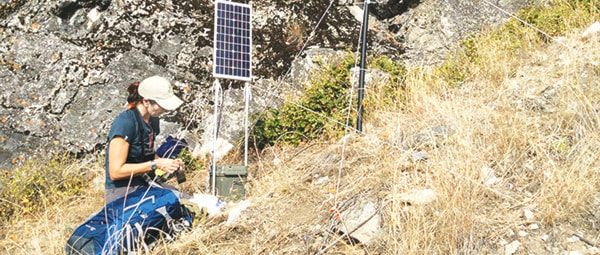While researchers might disagree with how bats are represented in horror flicks, there is still a lot of mystery surrounding the nighttime flyers.
Local researchers are using listening devices to get a better handle on the numbers of bats and species that are making their home in the Okanagan.
“Compared to birds and other bigger wildlife, we don’t have much of a clue about bats,” said Margaret Holm, Okanagan community bat program co-ordinator, “We don’t know that much about them. That’s why we’re asking for people’s help. If they do have a little colony, we would very much like to hear about it.”
Like bird calls, the echolocation cry used by a bat is unique to their species. By setting up listening stations, researchers like Tanya Luszcz can eavesdrop on the bats within a 10 kilometre radius as they zoom around chasing insects.
“Tanya will take an evening’s worth of recordings, put it into her computer and separate out the species from their calls,” said Holm. “She will be able to get very detailed information on the types of bats living in different habitats.”
Sampling is also conducted using a microphone attached to the roof of a car.
“It’s our form of a bat mobile,” said Juliet Craig, who is co-ordinating the North American Bat Monitoring Program (NABat) in B.C. “We drive at 30 km an hour down a road in one direction and listen in on the echolocation calls through the bat detector, which brings them down to a frequency we can hear. Then it’s like opening a present to find out which species were flying by.”
The bat detectors are part of the continent-wide program, which aims to monitor bat species distributions and relative abundance over time. This information is particularly important in B.C. since white-nose syndrome, the disease that is wiping bat populations in the eastern part of the continent, was recently confirmed in Washington and is expected to arrive in B.C. soon.
“In the West, we don’t have the big colonies like they do in some parts of North America, so we don’t have a good handle on wintering or summer populations,” said Holm, adding that creating a baseline census for bats is just getting started, compared to other species. “In the East, some populations have almost died out because of white nose syndrome and here in the West, we would hardly have any way of knowing because we have so little baseline data to know what is normal here.”
The idea is to create an annual count that can be compared year to year to determine how bat populations are faring, and which species are present. In the Okanagan, that’s a diverse group, according to Holm, finding niches in the many types of habitat that intersect here.
“We are bat central for Canada because of all the different species. We have some very unique bats that are only found here,” said Holm, adding that there are at least 15 species, some quite rare.
“There is nowhere else in Canada where you would have that many different kind of bats.”
Luszcz said it’s exciting to be conducting research in such a diverse area. But the researchers are also asking for help from area residents to add to their census.
“We also would really appreciate help from the public in identifying bat roosts and establishing bat counts at roost sites throughout the Okanagan and Similkameen, said Luszcz.
For more information visit www.bcbats.ca or contact the Okanagan Community Bat Program at okanagan@bcbats.ca or 1-855-922-2287. The web site is a comprehensive resource, providing information on attracting bats and managing bats in buildings.
